This exhibit brings together a powerful collection of artworks and historical artifacts that tell the story of farm workers’ struggles, resilience, and activism. Each piece offers a window into the fight for justice in the fields and the communities that continue this work today.
Below, you’ll find a list of represented organizations. Click on a name to explore the pieces identified from or with them.
Thank you for engaging with this history and honoring the voices behind it.
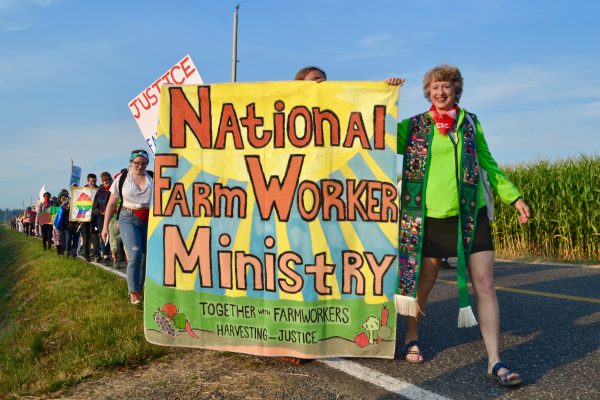
Banner and Buttons
National Farm Worker Ministry has been part of every farm worker campaign in the farm worker movement whether marching or participating in vigils and protests. The organization and its supporters are committed to standing in solidarity with farm workers.

Mt. Olive Pickle Boycott Tiara
When the National Farm Worker Ministry took on FLOC’s boycott of Mt. Olive Pickles, Joan Preiss made headbands and construction paper tiaras to wear in the grocery stores. “She would be at places where pickles were sold and ask people not to buy them. She was very involved in getting endorsements from churches for the Mt. Olive boycott.” Joan Preiss became involved in the farm worker movement in 1973 when she joined a friend who was starting a UFW movement in North Carolina to improve the living and working conditions for farm workers. The organization became the Triangle Friends of the United Farm Workers and was Joan’s career and guiding passion for much of her life. After the FLOC boycott of Mt. Olive was won, the focus changed to tobacco farm workers and, specifically, Reynolds American Tobacco Company which continues today.
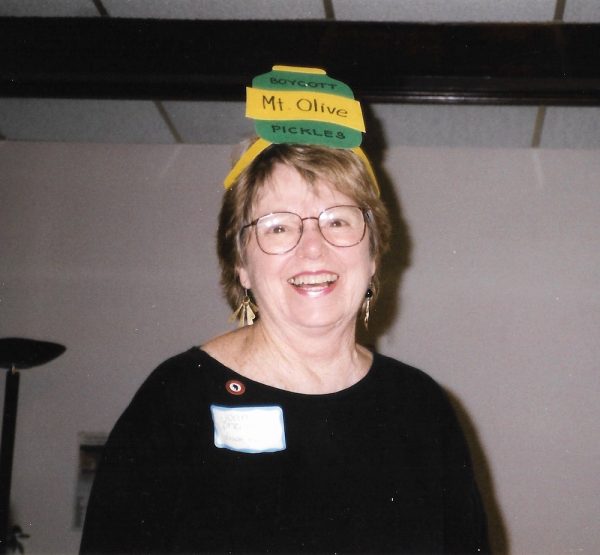
Joan Preiss
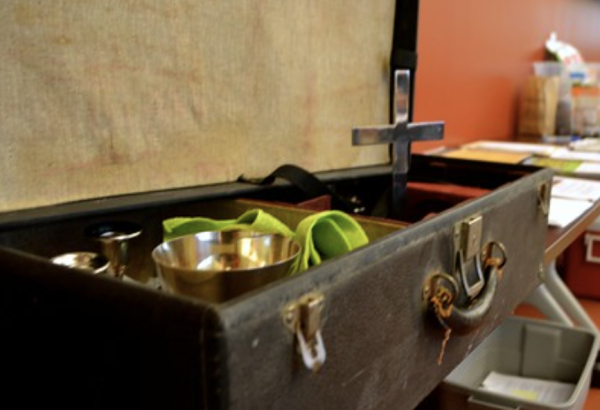
Communion Set
In the early days of migrant ministries, California Migrant Ministries and others across the US took items to represent religious sacraments to the farm labor camps. These were for the Eucharist, communion, healing prayers, baptisms, etc., to serve the people living and working so far from home. This was a welcome comfort and encouragement at the camps whose residents felt so isolated. Sharing in the ministry of presence with the farm workers, relationships formed and it was out of that environment that volunteers began to question the wages, treatment and living conditions of the workers. People of faith and conscience wanted to do more and Migrant Ministries became the National Farm Worker Ministry dedicated to advocacy and education in solidarity with farm workers.
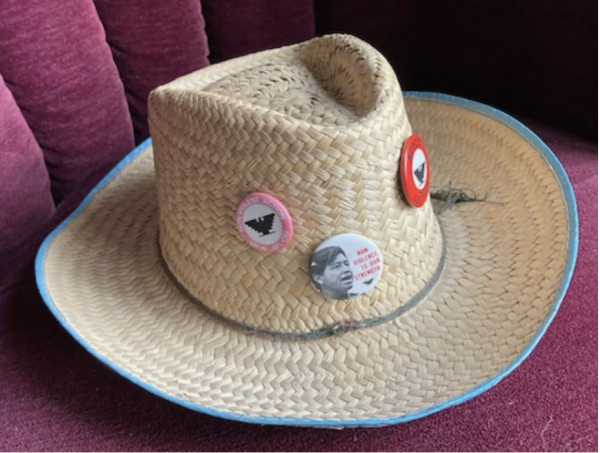
Straw hat and flag, a gift from Cesar Chavez, worn in 1973 with the UFW, National Farm Worker Ministry
On August 26th, 2022, Kimberly Emery, Julie Taylor, and Sylvia Campbell marched with the UFW for the last leg of their 335-mile journey from Delano to Sacramento. The day was a triumph of farm worker visibility, determination, faith, and resolve. During the march, Kimberly carried a small UFW flag, a symbol that NFWM is still here and still seeking justice with farm workers. The UFW flag was one that had been carried by Joyce Harmon in 1973 when she came to the Coachella Valley to stand with farm workers on the picket line. Joyce was one of the 95 delegates of the United Church of Christ Synod meeting in St. Louis, MO. Joyce kept that flag, a straw hat and a few buttons from 1973 until her death in 2021. After Joyce passed, her daughter Bethany sent it to NFWM, just in time for the 2022 UFW march.
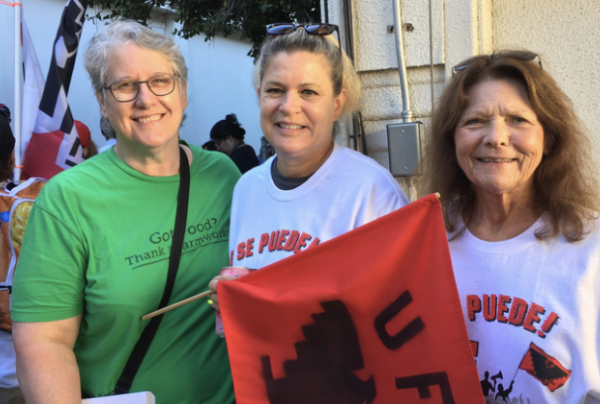
Julie Taylor, Kimberly Emery, holding Joyce’s flag, and Sylvia Campbell at the UFW March
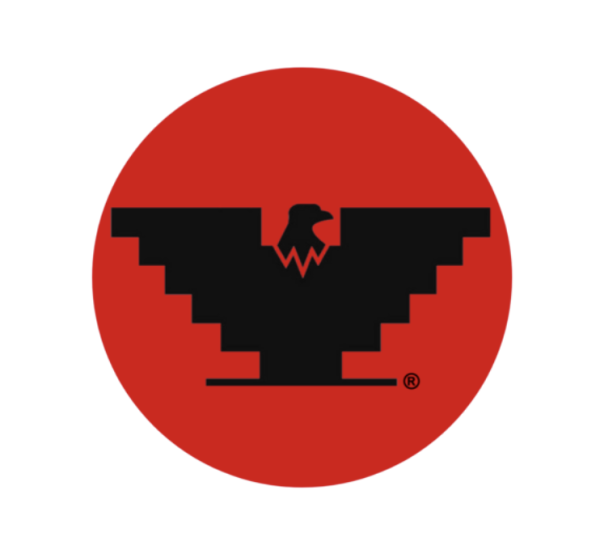
Flag
In 1962, Cesar Chavez asked his brother, Richard, to design a flag for the farmworkers’ union. Cesar wanted an Aztec eagle to encourage the farm workers. After several attempts, Richard sketched one on a piece of brown wrapping paper. He then squared off the wing edges so that the eagle would be easier for union members to draw on their handmade red flags. Cesar made reference to the flag by stating, “A symbol is an important thing and that is why we chose an Aztec eagle. It gives pride…When people see it they know it means dignity.” The flag was unveiled at the first mass meeting of the newly formed union.
Symbolism In The Flag:
The black eagle signifies the dark situation of the farm worker. The Aztec eagle is a historic symbol for the people of Mexico. The UFW incorporated the Aztec eagle into its design in order to show the connection the union had to migrant workers of Mexican-American descent, though not all UFW workers were/are Mexican-American.
(https://www.farmworkerlaw.com/ufw-tm-licensing)
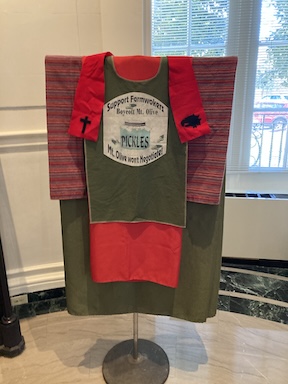
Mt. Pickle Boycott Apron
FLOC was founded in 1967 by Baldemar Velasquez and his father when they began organizing migrant farm workers in Ohio. FLOC is both a farm worker labor union (AFL-CIO) and a social movement in its own right. This union is the first to represent H2A guest workers under a labor agreement. FLOC is also known for creating and popularizing the corporate campaign format and pioneered the first three way bargaining agreement between corporations, growers and farm workers. The main goals of FLOC are to give farm workers a voice in decisions that affect them and to bring all parties to the table to address industry wide problems.
After successfully mobilizing farm workers and the general public to put pressure on the powerful corporations that buy from the growers, instead of the less-powerful growers who source their products to corporations, FLOC pioneered a historic three-way labor contract between farm workers, Campbell Soup, and tomato and cucumber growers in Ohio and Michigan. The contract was signed in 1986 after two years of talks and corporate campaigning. After that, in 1999, FLOC called a boycott of the Mt Olive Pickle Company, which in 2004 resulted in the signing of a union contract with the North Carolina Growers Association, covering thousands of H2A farm workers in that state. It has since been addressing the exploitation of tobacco workers in the state.
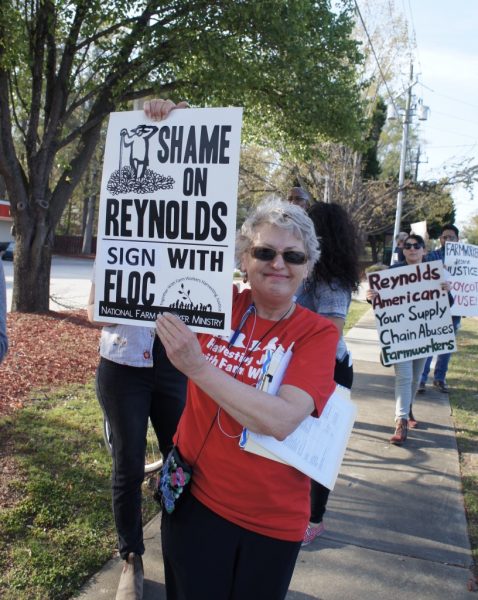
Susan Alan, Reynolds Protest
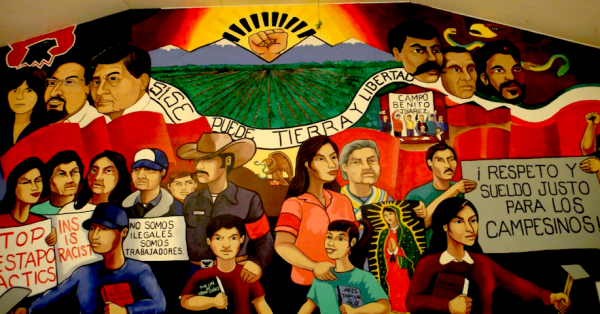
Mural, Designed and directed by Juanishi Orosco, Royal Chicano Air Force, based in Sacramento, CA in 1997.
Inspired by PCUN’s successful campaign to organize strawberry workers. April 1995 PCUN held its tenth convention and was determined to support recommendations to seek wage increases (from ten to 12 cents per pound to 17 cents per pound) for strawberry workers. The campaign included two major strikes and dozens of work stoppages. The strawberry campaign pushed growers to increase wages in the strawberry harvest by two to three cents per pound. Remembering Cipriano Ferrel (upper left), Founder and President of PCUN, who passed away in September 1995. This mural is displayed in the Risberg Hall (Union Hall) and features six deceased heroes of the working class struggle (upper left) Magdalena Mora, Cipriano Ferrel and César E. Chávez; (upper right side) Emilano Zapata, Benito Juárez and Ernesto “Che” Guevara.
Based in Woodburn, the center of Oregon’s agricultural industry, PCUN (Northwest Treeplanters and Farmworkers United), is Oregon’s farm worker union and largest Latinx organization in the state. Founded in 1985 by 80 farm workers, PCUN has since registered more than 6,000 members, 98% of which are Mexican and Central American immigrants, and to encompass a wide variety of organizing projects. PCUN’s fundamental goal is to empower farm workers to understand and take action against systematic exploitation and all of its effects. To achieve this end, PCUN is involved in community and workplace organizing on many different levels.
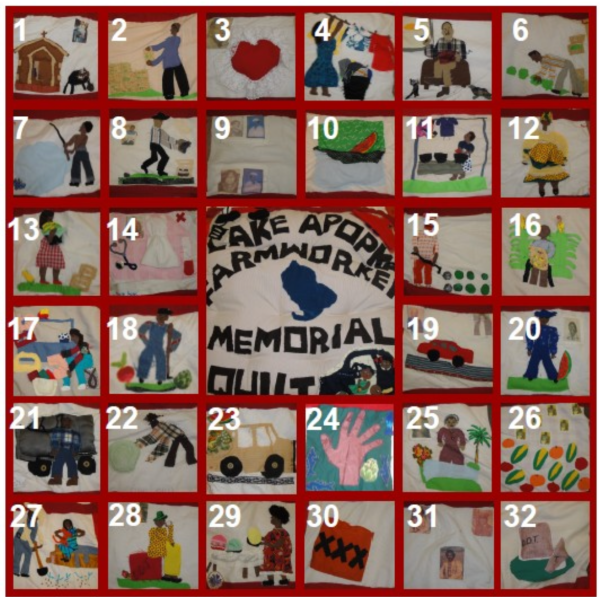
Pesticide Memorial Quilt
The Lake Apopka Farmworker Memorial Quilt is a tribute to the lives of farm workers who worked on the “muck” farms on Lake Apopka in Central Florida, harvesting and packing the vegetables that fed Americans for decades. Community members from Apopka and from the farm worker community of Indiantown created the memorial quilt as a way to remember their deceased loved ones and to raise awareness about the problems of pesticide exposure of Farm Workers and the long-term consequences to their health.
The Farmworker Association of Florida’s long-standing mission is to build power among farmworker and rural low-income communities, to respond to and gain control over the social, political, economic, workplace, health, and environmental justice issues that impact their lives. FWAF’s programs and activities build leadership, civic engagement, and activist skills among low-income communities of color who are disproportionately affected by pesticide exposure/health problems, environmental contamination, institutional racism, harassment and intimidation, exploitation, and political under-representation.
For descriptions of each square please click here.
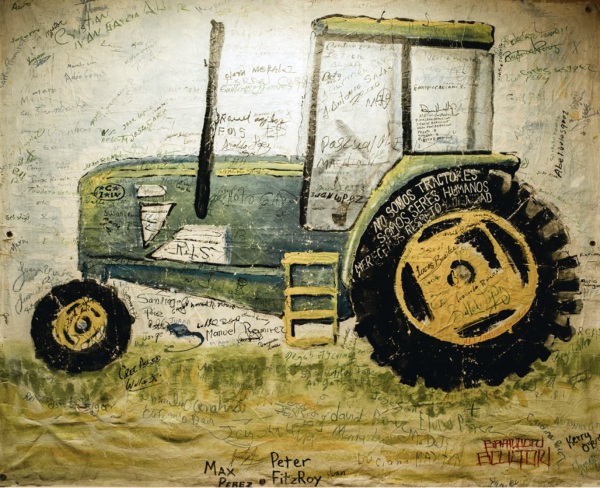
Tractor Mural and protest tools
The Coalition of Immokalee Workers is a worker-based human rights organization recognized for its achievements in the fields of corporate social responsibility, community organizing, and modern-day slavery and other labor abuses common in agriculture.
The mural of the tractor was inspired by a statement form Lucas Benitez, a founder of CIW:
“In 1997, during the 30 day hunger strike by 6 of our members, a friend of ours asked a grower why they weren’t willing to talk to us, and the grower answered, ‘Let me put it to you like this – the tractor doesn’t tell the farmer how to run the farm.’ That’s how they’ve always seen us – as just another tool, and nothing more.”
Senate Health, Education, Labor, and Pensions Committee on April 15, 2008 (https://ciw-online.org/blog/2008/04/lucas_senate_testimony/)
In 2001, CIW launched the Campaign for Fair Food with the first-ever farm worker boycott of a major fast-food company, the national boycott of Taco Bell, calling on the fast-food giant to take responsibility for human rights abuses in the fields where its tomatoes are grown and picked. After four years of negotiations, Taco Bell agreed to pay one cent more per pound of tomatoes directly to farm workers. This led to a partnership between the Campaign for Fair Food and the CIW to produce the Fair Food Program in 2011. Other fast food companies signed on to the Fair Food Program. Currently CIW is in a boycott of Wendy’s. The tools of placards, flags, puppets, signs and other creative items have been used in subsequent protests and marches.
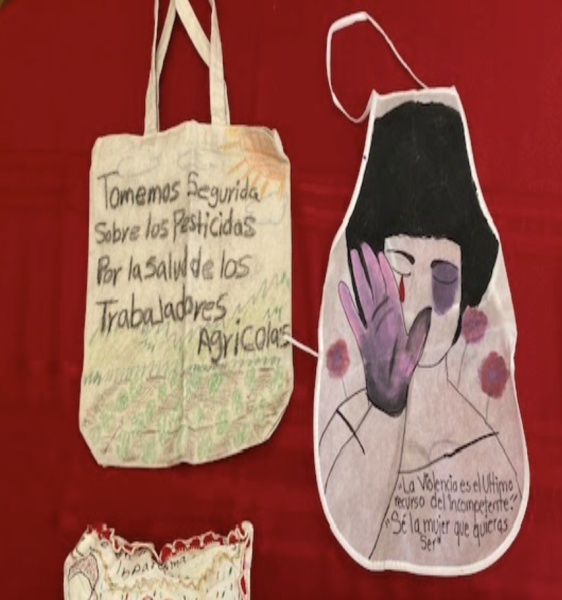
Apron, satchel, and bandanas
Alianza Nacional de Campesinas (National Alliance of Women Farm Workers), the first national women’s farm worker organization, fights for the human rights of campesinas. The Mandilitos (“little aprons”) project was initiated in 2008 by Alianza founding member Organización de California de Líderes Campesinas (Organization of California Women Farm Worker Leaders).The Little Aprons represent the aprons that women usually wear in the home. Farm workers, their families and community members across the country decorate the mandilitos with messages to end violence and exhibit them in multiple sites in their communities. The exhibits serve as an organizing tool for open dialogue.
Another way that attention is being brought to workplace sexual violence against farm worker women are bandanas. Farm worker women use layers of clothing including hats and bandanas, as shield to help protect themselves from harassment and sexual violence while working in the fields. Allies decorate these bandanas in an attempt to help support, fortify and empower farm worker women as they face this difficult problem in the hopes that they will no longer have to suffer in silence.
Alianza Nacional de Campesinas launched the Morralitos (“Little Satchels”) Campaign to create public awareness about the health risks of pesticide exposure for farm worker women and their families.
Paintings
The mission of Migrant Justice is to build the voice, capacity, and power of the farm worker community and engage community partners to organize for economic justice and human rights. One of Migrant Justice’s largest campaigns is the Milk with Dignity Program, modeled after the CIW Fair Food Program, a worker-driven socially responsible model. This campaign builds a movement of dairy workers and allies calling on dairy companies to ensure respect for human rights in their supply chain. In 2017, Ben & Jerry’s signed on to the Milk with Dignity Program. Currently, Migrant Justice is trying to get Hannaford Supermarkets to join.
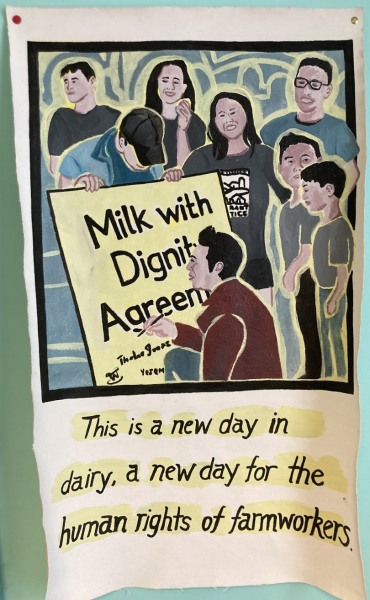
Victor Diaz, Artist: Michelle Sayles
Victor Diaz is a longtime leader of Migrant Justice as part of the farmworker Coordinating Committee. This picture shows Victor signing the Milk with Dignity agreement with the rest of the Coordinating Committee members and the Ben & Jerry’s CEO on October, 3, 2017. This was the historic day that the company finally signed onto the Milk with Dignity Program after nearly 3 years of public campaigning.
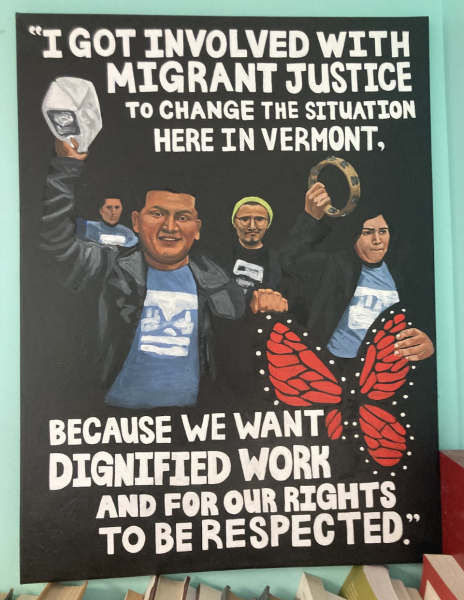
Thelma Gomez & Bento Sanchez, Artist: Dana Keyes-Gibbons
Thelma Gomez is an organizer with Migrant Justice and Bento Sanchez is a community leader. This picture is from a May Day march calling on the ice cream company, Ben & Jerry’s, to sign onto the Milk with Dignity Program and bring rights and dignity to farm workers within their northeast supply chain.
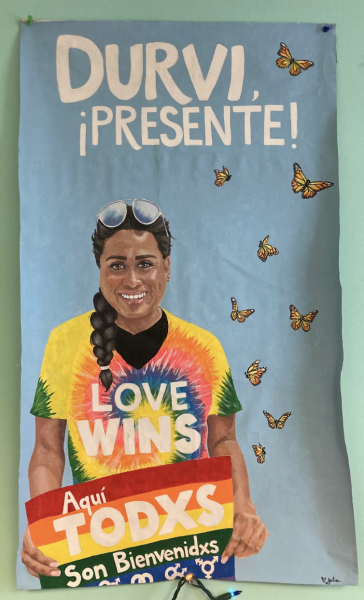
Durvi Martinez, Artist: Julia Berberan
This painting is a tribute to Durvi Martinez. Migrant Justice leader Durvi died on July 1st 2020 from COVID-19. Durvi contracted coronavirus soon after being deported from Vermont to Mexico. Durvi, a trans woman who had suffered severe violence before immigrating to the United States, was deported despite a pending asylum claim. When the coronavirus pandemic began spreading in immigration detention centers in March, ICE chose to quickly deport Durvi, ignoring the asylum claim and failing to notify Durvi’s lawyer. Rather than releasing Durvi, ICE deported them to their death.

José Ramos, Artist: Dan Quigley
José is one of many farmworkers who have faced abuse at the Goodrich Farm in western Vermont. Workers over the years have reported violent mistreatment and stolen wages. In March of 2020 José decided to call on his community to stand with him. On Saturday morning, farmworker José marched down a back road in Addison County at the head of 50 fellow workers, neighbors, students and faith leaders. When the crowd arrived at the notorious Goodrich Farm the owners came charging at the marchers, pushing people and shouting obscenities. José ended up eventually winning a stolen wage case with the Department of Labor but it took more than a year for him to get his pay. He has since become involved in the campaign to bring the labor protections of the Milk with Dignity Program to more farms.
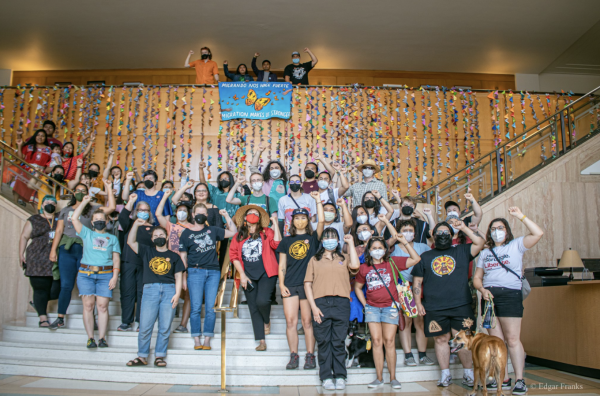
Origami Butterflies
Washington state has faced record heat and low air quality putting many communities at risk, particularly farm workers. Farm workers are 20 times more likely to die from heat stress than any other workers. In 2017, Honesto Silva IBarra, 28 years old, husband, father of three children and migrant worker with a temporary visa, died from extreme heat and exploitative conditions in Sumas, Washington. Honesto’s tragic and unjust death became the face of the movement, building to the Migration Makes Us Stronger Campaign in 2022. Community to Community’s Migration Makes Us Stronger Campaign advocated for a city-funded immigration resource center. As part of a protest the community made 10,000 origami butterflies to hang around city hall and local businesses in Bellingham, Washington. Like monarch butterflies who have long annual migration, the origami butterflies represent the journey of migrant farm workers in the U.S.
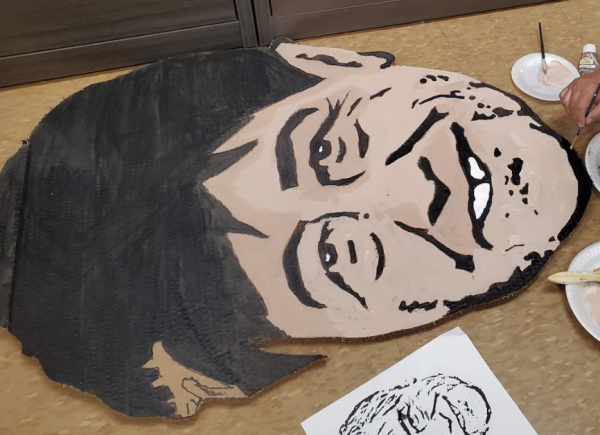
Cesar Chavez Placard
After so many victories for farm worker rights, LUPE was born out of a need to advocate for infrastructure in rural communities. Rooted in the legacy of labor rights champions César Chávez and Dolores Huerta, LUPE empowers residents of the Rio Grande Valley’s colonias to drive social change through active civic engagement. LUPE fosters stronger, healthier communities by equipping residents with the tools and voice to advocate for their needs.
Nestled in the heart of deep South Texas, Hidalgo County, LUPE operates within a critical border region. This area boasts the highest concentration of farm workers in Texas, including numerous migrant and H2A workers who follow the seasonal harvests. A significant portion of these agricultural workers remain within the “golden cage” of the Rio Grande Valley, a term reflecting the presence of stringent immigration checkpoints to both the north and south.

Levante Leadership Institute and The Beehive Collective
The mural was created in 2012 by a Student Action with Farmworkers’ youth group, Levante (“to raise up”) Leadership Institute, in collaboration with The Beehive Collective. The story of farm workers is a story of human labor working the land and a story of struggles for justice across generations. Spanning the width of this graphic are fields of crops and metaphors of power juxtaposed on a literal landscape with farm workers at the very center. This is used by interns as they teach farm worker rights in labor camps throughout the state of North Carolina. It is a popular education tool that does not rely on a person’s ability to read words but to understand pictures and representations of power imbalance, solidarity and exploitation.

Canvas Paintings
Ayudando Latinos a Sonar (ALAS), a grassroots organization in Half Moon Bay, California, was born from the desire to help children and their families feel proud of their identity and culture and amplify their voices.
On January 23, 2023, a horrific tragedy unfolded. Chunli Zhao opened fire at California Terra Garden, his former workplace, leaving four coworkers dead and another wounded. He then drove to Concord Farms, where he fatally shot three more workers. This devastating event ripped the veil from the harsh realities of working and living conditions at these mushroom farms. The investigation revealed that farm workers in Half Moon Bay endured unsanitary and unsafe environments, including makeshift housing in shipping containers, mold-infested rooms, and dilapidated trailers. These conditions, a stark violation of federal labor laws, are unfortunately not unique to mushroom workers, but rather a pervasive issue across countless farms nationwide.
In January 2024 ALAS held an Anniversary Remembrance Ceremony to remember the lives of the 7 farm workers who were killed in this mass shooting. These paintings were created by farm workers who were displaced, witnesses, survivors of this violence.

Flags and Pins (Elizabeth Rodriguez)
Founded by Victor SanMiguel, Carnalismo Brown Berets is a grassroots nonprofit serving underprivileged communities. They utilize the Aztec eagle, a symbol of culture and unity inspired by Cesar Chavez, and clasped hands to represent solidarity. Chapters nationwide volunteer and partner with other nonprofits to advocate for minority resources and opportunities. They fundraise to improve vulnerable populations’ lives and provide free security for peaceful demonstrations.
A historic Union Flag, bearing pins collected during the 1966 Watermelon Strike from stops between Rio Grande to Austin, Texas, was donated to Carnalismo Brown Berets. This artifact, authenticated by University of Texas, Rio Grande Valley archives, symbolizes the power of collective action and is preserved as a core part of their identity.

Graphic, Marco Lopez
As an activist, Marco Lopez has always loved using propaganda as a tool to invite folks to events, protests, and marches. He found himself running into the same pictures of revolutionaries that he felt were not representative of him. Lopez sees this as erasure of Mexican culture along the border. His longing to reconnect with his Mexican roots and its indigenous cultures was bolstered by his connection to Mexican imagery calling it Pre-Tzilacatzin (one of the last warriors to resist the conquistadores) art. Follow Marco @shipleysart
Founded in 1979 by migrant farmworkers in New Jersey, CATA is a grassroots organization with a membership of farmworkers and the Latino immigrant community in New Jersey, Pennsylvania, and Maryland. CATA’s work focuses on workers’ rights, workplace health and safety, immigrant rights, and food justice. The Mission of CATA is to empower farmworkers and immigrant workers to fight for their rights so they can live a full life.

Photo, Dolores Huerta on the Sueldos Justos Women and Children’s March in Lamont, CA
The Dolores Huerta Foundation is dedicated to inspiring and mobilizing communities. Built around Dolores Huerta, co-founder of the United Farm Workers Union, her legacy of advocacy and community organizing has had a profound impact on young people.
The Dolores Huerta Foundation’s mission is to cultivate empowered volunteer organizations who actively pursue social justice. Their grassroots organizing efforts in civic engagement, education equity, health and safety, and LGBTQIA+ equality aim to amplify the voices of those most directly affected by inequity. This organization recognizes the inherent knowledge and capacity of marginalized people to implement community-driven solutions when equipped with the necessary tools, training, and resources.

Dolores Huerta
[/bs_collapse]

